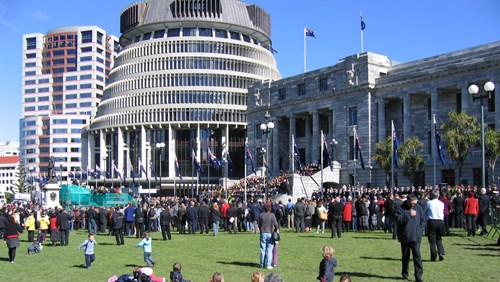
Australia Poised to Lead Crucial Tariff Amid Trade War
As Energy Minister Bowen flags a carbon tariff on some imports, Australia well placed to lead development of a path towards a regional Asian Carbon Border Adjustment Mechanism
A new report by independent think tank Climate Energy Finance (CEF) finds that carbon border tariffs in international trade are urgently required to put a price on the carbon emissions embedded in the production of industrial commodities such as iron and steel, aluminium and cement, which make up 15% of global emissions. This will help correct the historic market failure to price carbon that has fed into to the climate crisis, and support global emissions reduction goals. Critically, it will shift investment from fossil fuels into clean energy and the production of ‘green’ industrial commodities.
Unlike the erratically applied, economically and industrially-destructive and investment-deterring tariffs imposed across the board by the US, carbon border adjustment mechanisms (CBAMs) drive the green transformation of countries’ energy systems and industrial bases. This in turn underpins nations’ economic resilience, prosperity and energy security as the world economy approaches net zero.
On 1 June 2025, newly re-elected Energy Minister Chris Bowen flagged that Australia is considering imposing a CBAM on imports such as cement and steel. The CEF report ‘A Price on Carbon: Building Towards an Asian CBAM’, argues that:
The report finds that effective international carbon pricing requires four pillars:
1. Sufficiently high domestic carbon pricing within nation states – in Australia, a ratcheting-up Safeguard Mechanism – to spur investment into decarbonisation of industrial products so they are produced using zero-emissions energy, such as green iron. Private finance can’t be mobilised at speed and scale into green commodity opportunities unless a carbon signal is priced-in to corporate balance sheets to catalyse investment.
2. A CBAM applying to imports to lift climate ambition and level the trade playing field between countries that price carbon and those that do not, or have weaker pricing. Minister Bowen has now flagged this.
3. Complementary industrial policy measures including domestic state-supported market incentives for green commodities (such as production tax credits) in the interim until regional and global carbon pricing is in place. The Australian government has put in place a number of such incentives.
4. Intensive collaboration with key trading partners on regional carbon pricing to time-limit the above support measures and to accelerate the ‘new energy trade’ – trade in green industrial products.
The Albanese federal government enjoys an overwhelming mandate from the recent reelection for its green superpower agenda. It is well placed to advocate for an Asian CBAM in the run-up to COP31 given its political influence as a middle power in the Asia-Pacific and the resources and energy trading partner of choice for much of the region’s industrial base, its abundance of renewables and the minerals and metals needed for energy transition, and as the world’s largest exporter of iron ore with boundless green iron potential.
The report’s lead author, CEF Net Zero Transformation Analyst Matt Pollard, said:
“Australia should build on the intention Minister Bowen has now flagged to consider a carbon tariff on some imports in this term of government, and accelerate efforts to advocate for a regional carbon pricing framework – a CBAM – in alignment with key trading partners.
“For Australia, as the viability of its historic dependence on fossil fuels as a top-three global exporter enters gradual, but inevitably terminal, decline, the net zero transition is an immense opportunity to pivot to clean commodities such as green iron and reposition as a zero-emissions trade leader. Failure to act as a key economic agent in shaping the green industrial boom is a significant risk to its future energy and national security, and economic resilience.
“Climate-focused domestic industrial policies across the Asia-Pacific are increasingly putting a price on carbon. Our report highlights this momentum, with 17 carbon pricing schemes in effect, including China’s ETS and schemes in South Korea, Japan and Singapore. It is in industrious Asian economies’ national interests to now leverage this, working with partners with comparative advantages in the new energy trade and low-cost renewables, such as Australia, to create a regional market in decarbonised commodities like green iron and steel, aluminium and cement. An Asian CBAM is key to this.
“A joint commitment to build towards an Asian CBAM and complementary measures can provide a mutually-beneficial pathway for Asia and Australia to prosper in a rapidly decarbonising world.”
CEF director Tim Buckley, a former MD of global investment bank Citigroup said:
“We applaud Minister Bowen’s statement that he will consider a carbon tariff on some products such as steel and cement. The lead up to COP31 is also an opportunity for Australia to build on our domestic momentum as we price in industrial carbon emissions via the Safeguard Mechanism and decarbonise our electricity system, creating a path to an Asian CBAM. Initially in economically-advanced East Asia and Australia, a regional CBAM would mobilise private capital at speed and scale for decarbonising international trade. This would align and leverage the EU’s climate leadership demonstrated in its CBAM, accelerating the global race to decarbonise in alignment with the immutable climate science.
“Australia is a mining sector world leader, but we export with next to zero value add. A carbon price in international trade would mobilise hundreds of billions of dollars of new investment to leverage our world-leading renewable resources so our commodities can be processed on shore with zero-emissions energy, embedding decarbonisation in our industrial goods pre-export. An Asian CBAM is 100% aligned with Australia’s national interest, a more sustainable economy and a liveable planet.”
Baethan Mullen, CEO of The Superpower Institute, a not-for-profit founded by renowned economist Professor Ross Garnaut and policy expert Professor Rod Sims to help Australia seize the economic opportunities of the post-carbon world, said:
“Carbon pricing is the most efficient policy tool available for addressing the harm caused by carbon emissions. It is essential that Australia plays its part in the development of an international system of carbon prices.
“The Superpower Institute welcomes this important piece of work by CEF. It is clear and compelling in its analysis and provides a prescription for Australia to integrate with the world’s move to carbon prices and carbon border adjustment mechanisms.”
Dr Elizabeth Thurbon, Professor of International Political Economy at UNSW and Director of the Green Energy Statecraft Project, said:
“The recommendations in this report address the fundamental market formation challenges currently preventing investment in clean commodity production. They provide the long-term policy solutions needed to seize the once in a generation economic, environmental and geostrategic opportunities facing Australia. Building towards a price on carbon through international commodity trade enables urgent policy levers like multilateral clean commodity trading initiatives that are necessary to support first of a kind projects.
“The forward-looking approach to international engagement on carbon pricing, as laid out by CEF, will allow Australia to shape emerging markets rather than simply respond to them. It exemplifies the sophisticated green energy statecraft needed to speed up the global energy transformation and maximise its national benefits.”
Charlie Caruso, General Manager (WA) of Smart Energy Council and National Business Development Manager at Zero Carbon Hydrogen Australia, said:
“This report highlights that building towards an Asian CBAM is not only a statement of climate ambition, but a strategic move to harmonise decarbonisation efforts, reward low-emissions production, and embed carbon integrity in our exports.
“The Smart Energy Council welcomes this timely and insightful contribution from Climate Energy Finance. It presents a compelling roadmap for how Australia can lead the region in embedding carbon integrity into international trade. As global markets pivot to cleaner supply chains, this work provides the policy clarity needed to align decarbonisation with trade competitiveness, and to strengthen Australia’s position as a clean energy superpower in the Asia-Pacific.”


